How to use Histamine NutrientsUpdated a month ago

Histamine is a natural compound in the body. It’s triggered by allergies, stress (both emotional and physical), certain chemicals, infections (like bacteria, viruses, fungi, and parasites), medications, injuries, and even physical things like pressure, temperature changes, or vibrations.1
After histamine is released and does its job, your body needs to break it down so histamine levels return to normal. You don’t want to have high histamine levels lingering around all the time. That makes for problems.
Two main enzymes are in charge of breaking down histamine:
 If these enzymes don’t work fast enough (i.e., they’re dirty), histamine levels become elevated, leading to symptoms.2 By supporting both of these enzymes, along with their downstream ones such as MAO, ALDH, and NAT2, it’s possible to have healthy histamine levels.*
If these enzymes don’t work fast enough (i.e., they’re dirty), histamine levels become elevated, leading to symptoms.2 By supporting both of these enzymes, along with their downstream ones such as MAO, ALDH, and NAT2, it’s possible to have healthy histamine levels.*
Symptoms of high histamine can vary by where the high histamine is taking place.
Here is where the DAO and HNMT enzymes are most active:23
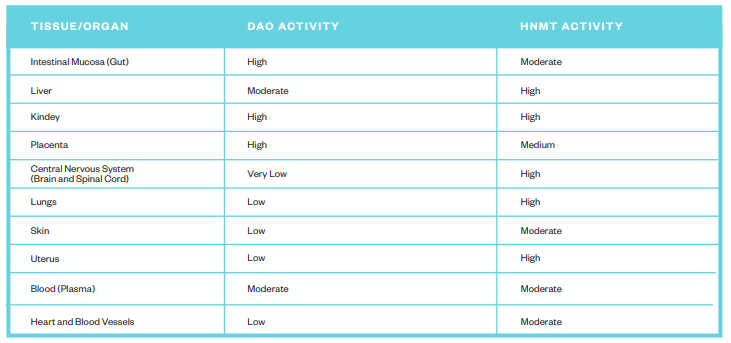
How’s Your Histamine Level Right Now?
Referencing the table below, identify what the majority of your current experiences are:
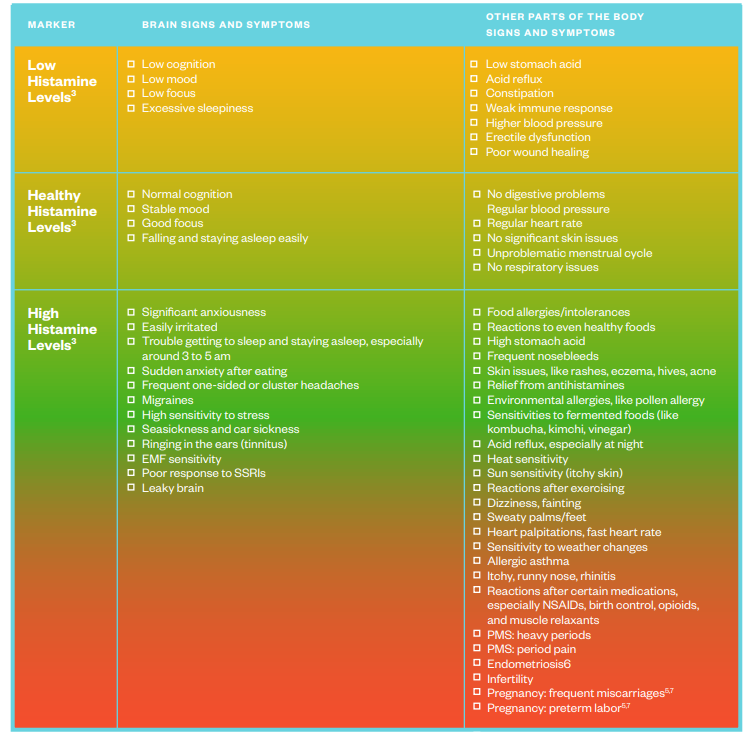 How to Support Healthy Histamine Levels
How to Support Healthy Histamine Levels
When histamine levels are high, you may experience symptoms in multiple areas: the gut, mood, skin, bladder, and immune system. These symptoms may manifest as allergies or intolerances.
Dr. Lynch formulated Histamine Nutrients to help maintain healthy histamine levels.†
There may be times when you need to take it a few times a day and other days when you don’t need it at all.
Only use Histamine Nutrients when your histamine levels are high, as it supports healthy histamine levels.†
Histamine Nutrients is suitable for:
• Children over the age of 4.
• Breastfeeding mothers: High histamine levels during breastfeeding may be associated with infant eczema and colic.8,9
• Pregnant women: High histamine during pregnancy can be associated with pregnancy complications, especially during the first trimester.
NOTE: This product contains an ingredient derived from porcine (pig). Avoid if allergic to pork or any other ingredient. It is not suitable for vegetarians and vegans. Histamine Nutrients is not effective for gluten sensitivity or for celiac disease or anaphylactic allergies, such as peanuts, shellfish, eggs, dairy, etc.
How to Take Histamine Nutrients
Histamine Nutrients can be taken any time of the day or night, as needed.
Daytime: Use during the day to support healthy histamine breakdown.†
Evening time: Use during the evening to support a healthy onset of sleep.†
Most individuals experience healthy histamine levels by taking 2 capsules of Histamine Nutrients.
Some need additional support.
Further Support Your Histamine Levels: Add one or more of these as needed with Histamine Nutrients.†
| Histamine Digest | HistaminX | Probiota Histaminx |
| Gut and Pregnancy | Mast Cell Activation | Gut |
| Breaks down histamine in the gut and from the placenta† | Supports healthy storage of histamine within the mast cell† | Supports and establishes healthy histamine levels in the microbiome† |
| As needed, anytime, take 1 capsule before eating or drinking. Alternatively, as needed, take 1 capsule away from food or drink if wanting to support uterine comfort during the menstrual cycle, occasional nausea from pregnancy or healthy histamine levels in your digestive system. | Take upon waking and away from food as needed | Take after dinner each evening |
Additional tips on how to take Histamine Nutrients: You may open a capsule and mix the powder into a bite of organic applesauce or a bite of food. Do not mix in juice as the SAMe ingredient is irritating to tissues.
The Pulse Method by Dr. Lynch
The Pulse Method is Dr. Lynch’s method for starting, pausing, or stopping a supplement based on how you’re feeling. Implement this method after consulting with your healthcare practitioner and introducing a new supplement into your diet and after consulting with your doctor,.
The Pulse Method has helped people reduce side effects, support healthy outcomes, and save money.
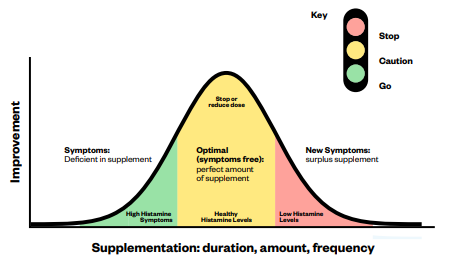
What Does It Mean To Supplement
The word supplement literally means “to add to or enhance”. Supplementation is used to “top off” nutrients you should already receive daily from eating though sometimes you may not. It is also a tool to aid the body in supporting nutritional balance, which can be offset due to poor food quality and a lack of essential vitamins and minerals.
• Use only as needed. Some days, you’ll need more, and other days, you’ll need less. Some days, you may not need it at all.
• Look at the Histamine Symptoms chart above.
• Take it when you have ‘High Histamine Levels’ and stop taking it when you don’t.
• Take as recommended by your healthcare professional.
Real-life Usage Scenarios:
• A 29-year-old female suffering from painful periods takes 1 capsule morning and night. She struggled from eczema, nervousness, and an irregular heartbeat. Now she experiences overall wellness, especially in regards to menstrual comfort.†
• Dr. Lynch’s wife takes Histamine Nutrients on the airplane with her. She gets headaches from barometric pressure changes during takeoff and landing. Now she travels by air comfortably as she takes Histamine Nutrients before takeoff and again, if the flight is longer than 3 hours, another before landing.†
• When Dr. Lynch, or his family members, cannot fall asleep quickly, Histamine Nutrients is taken before bed to support a healthy onset of sleep.†
• Many people take this daily to support a healthy histamine response to pollen, mold, dander, dust, and other environmental compounds.†
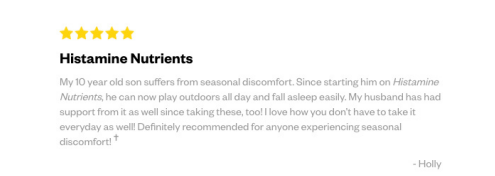
How to Further Optimize Your Histamine Levels
• Reduce intake of high-histamine foods and drinks, such as leftovers, fermented and aged foods, such as alcohol and aged meats and cheeses, kombucha, bone broth, condiments, collagen powder, and sauces.
• Test for and avoid allergens. This includes both environmental allergens and those from your diet. Identifying and eliminating these triggers can significantly reduce histamine reactions.
• Optimize methylation by eating a diet rich in the nutrients that support it, like choline (egg yolks), folate (dark leafy greens), vitamin B12 (animal products), and methionine (meat and eggs). Supplement if needed.†
• Avoid probiotics containing Streptococcus, L. bulgaricus, L. fermentum, and L. casei. If relevant, reduce histamine-producing gut species. Implement stress-reduction techniques, such as meditation, yoga, gardening, community, nature, or deep breathing exercises. Stress worsens histamine intolerance symptoms, so managing it effectively is important.
• Filter your air with an air filter. Dr. Lynch uses and recommends Alen Air.
• Address SIBO (small intestinal bacterial overgrowth) if relevant. Supporting your liver and gallbladder is very important. Read our Guide. Work with a healthcare professional to best tackle it.†

Life Events Associated with High Histamine
We typically associate high histamine symptoms with allergies, such as a runny nose, watery eyes, and skin rashes. However, high histamine levels can manifest in other types of symptoms we don’t typically think about.
Intolerances and allergies3
Histamine is best known for helping the body deal with allergies by eliminating things that cause harmful reactions. When there's just the right amount of histamine, it's helpful. But when there's too much, it can make the body overreact to things that aren't actually life-threatening, such as some healthy foods, exercise, and fragrances.
Sleep Issues10,11
High histamine levels can keep you from feeling sleepy because histamine works as a stimulant molecule in your brain, participating in controlling your sleep-wake cycle. That’s why some types of antihistamines can make you feel drowsy.
Tip: What you eat before bed could be the main culprit for your sleep troubles. Food and drink that are high in histamine or ones you're sensitive to should be avoided in the evening if you are trying to improve your sleep.
Psychiatric and Neurological Disorders12
Histamine triggers the release of brain chemicals like dopamine, norepinephrine, and serotonin. Because of this, histamine can naturally influence how we think, feel, and act.
It has been shown to be involved in various brain disorders, such as anxiety, panic, bipolar disorder, Tourette’s Syndrome, and even schizophrenia.
PMS13,14
Mast cells and histamine are strongly affected by the hormone estrogen.
Many women notice their histamine symptoms get worse right before ovulation and just before their period. This happens because estrogen boosts histamine levels and activates mast cells. As histamine increases, it also causes estrogen levels to rise even more, which starts a cycle that keeps going.
Pregnancy Complications15,16,17
The following conditions are related to higher-than-normal histamine levels:
• Extreme Pregnancy Sickness (Hyperemesis Gravidarum): A serious type of morning sickness affecting 0.5 to 3% of pregnancies. It causes severe nausea and vomiting, which can lead to dehydration and poor nutrition, putting both the mother and baby at risk. This is related to increased histamine levels, which is why doctors prescribe antihistamines as the go-to treatment for managing morning sickness.
• Pre-eclampsia: A condition during pregnancy where a woman has high blood pressure and possible damage to organs. It happens when the blood vessels in the placenta don't develop properly early in pregnancy. This may be caused by high histamine levels or low levels of DAO enzymes.
• Miscarriage and early birth: High histamine levels can raise the risk of miscarriage and early birth. This happens because histamine can affect blood vessels and the muscles in the uterus, causing them to contract too soon.
Look at our free Morning Sickness Guide to learn more about supporting healthy histamine levels during pregnancy.
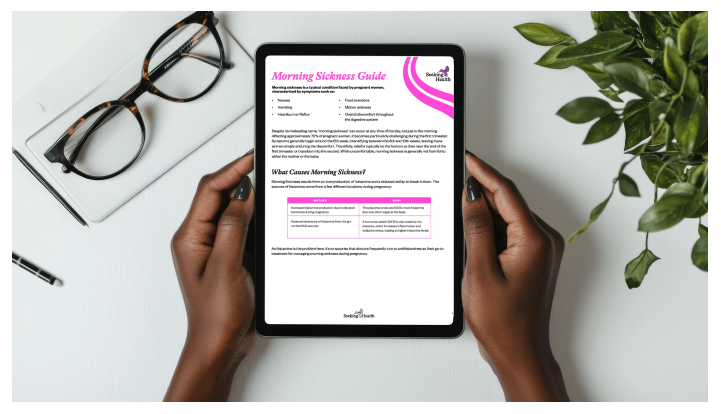 Irritable Bowel Syndrome (IBS)18
Irritable Bowel Syndrome (IBS)18
IBS is a term used to describe certain symptoms, not an actual disease or a main cause. One possible hidden factor could be histamine.
The symptoms linked to histamine intolerance are things like bloating, stomach cramps, feeling nauseous, unpredictable bathroom habits, and food sensitivities.
If you’ve been diagnosed with IBS, take note if you have these symptoms, especially after eating foods that are high in histamine or trigger the release of histamine. Some examples of these foods are citrus fruits, tomatoes, avocados, spinach, fermented foods, bone broth, collagen powder, kombucha, etc.
Long-Term Viral Effects19,20
For people who are already more likely to have certain health issues, like histamine intolerance, some viruses can cause long-lasting immune system activation, leading to mast cells releasing too much histamine.
Mast cells are a type of immune cell that store and release histamine. They are found in high amounts on a cell receptor called ACE-2, the entry point for viruses. These mast cells can be triggered and stay active even after the virus is no longer in the body.
Headaches and Migraines24, 25
Histamine is an excitatory neurotransmitter and also increases blood flow.
Commonly, the histamine that gets into the brain has been absorbed from the gut, gets into the blood, and then gets into the brain. Thus, by removing food allergies and intolerances and healing the gut, one may eliminate their recurring headaches and migraines.
It’s best to support healthy histamine levels in the gut first with a combination of Histamine Digest and ProBiota HistaminX.†
Supportive supplements for Histamine Nutrients:
Below are some supplements, apart from those that you can use to stack with Histamine Nutrients, that are supportive of healthy histamine levels:†
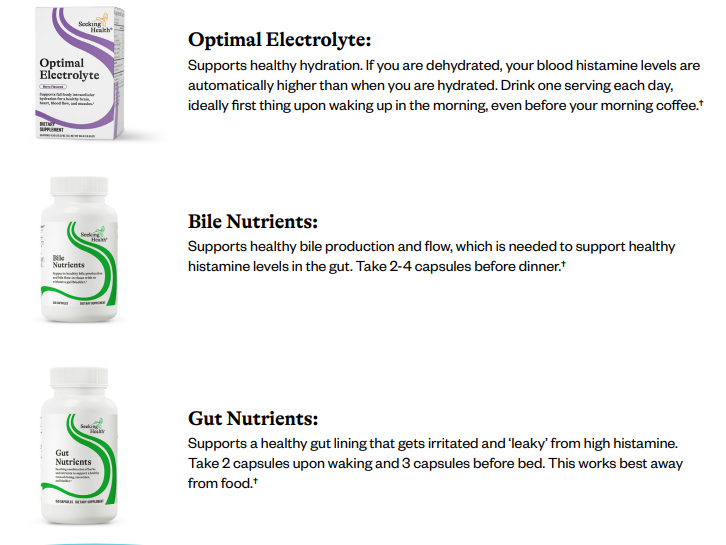 FAQ’s
FAQ’s
What is the difference between Histamine Nutrients and antihistamines?
Antihistamines work by binding to histamine receptors. This prevents histamine itself from binding to and activating receptors. This reduces your histamine symptoms but does not change your histamine levels. Your histamine levels still remain high. This approach does not address the real issues, which are typically†:
• Not breaking down and eliminating histamine properly.
• Producing too much histamine.
• Releasing too much histamine.
Histamine Nutrients, on the other hand, does not bind to histamine receptors in the way antihistamines do. Instead, it supports the healthy breakdown and elimination of excess histamine in the gut and body. Unlike antihistamines, it changes your histamine levels from high to healthy.†
Antihistamines aren’t the solution.
Balancing your histamine levels is.
Why am I producing so much histamine in the first place?
Common triggers for higher histamine production and release include:
• Infections (bacteria, viruses, parasites, fungi)
• Gut dysbiosis
• SIBO (small intestinal bacterial overgrowth)
• Mold exposure
• Allergen exposure (pollens, dust, grasses)
• Hormone imbalances (excess estrogen and/or lower progesterone)
Pretty much anything that stimulates your immune system to respond will result in more histamine production and release. Whilst histamine release is part of a healthy immune response, it’s more likely to become problematic if the immune system overreacts or does not shut off after a reasonable amount of time.
Find and address triggers that could be making your histamine symptoms worse.
Why am I not breaking down and eliminating excess histamine?
You may be deficient in some of the nutrients needed to break histamine down.
You may also have some dirty histamine genes that you were either born with or got dirty.
Use Histamine Nutrients and/or stack with some of the other histamine support suggestions while investigating your reason for having high histamine.†
Can I take Histamine Nutrients and Serotonin Nutrients together?
Yes, you can.
It is possible to have both high histamine and low serotonin levels. Keep track of your symptoms. You may need to stop one of them when symptoms related to that supplement are resolved, while continuing with the other. Or pulse them.
If you are unsure, work with a healthcare professional. Taking both supplements is very much a case-by-case scenario.
I’m female, and my histamine symptoms get worse during certain parts of my menstrual cycle. Why would that happen?
Histamine levels rise and fall with estrogen.
Estrogen (estradiol) increases the number of mast cells and histamine release in the ovaries. Progesterone stabilizes mast cell membranes and reduces histamine release.
Estrogen levels are typically higher the week before your period and around ovulation. If you have high histamine symptoms, they may be more pronounced during these times of your cycle.
Add more support when needed†:
• Histamine Nutrients: Take 2 capsules if you usually just take 1 capsule.
• Stack with Histamine Digest, HistaminX, or ProBiota HistaminX at these times.
• DIM + I3C: Support healthy estrogen levels as high estrogen stimulates high histamine. Take 1 capsule after dinner starting about 10 days before ovulation as this is when estrogen starts to rise and peak. Once you ovulate, stop taking DIM + I3C as this is when estrogen levels really drop.
Refer to the ‘How to Take Histamine Nutrients’ section for more guidance.
There are also other supplements that may maximize the effect of Histamine Nutrients if you have deficiencies or an extra need for these nutrients.†
Refer to the ‘Supportive Supplements for Histamine Nutrients’ section.
Histamine Nutrients was helping me, but now it’s not. What happened?
There are so many variables, especially as we push one system and ignore another. Some things to consider:
• Check your homocysteine levels. You want them around 6 to 8 umol/L. Histamine won’t be broken down properly if homocysteine levels are too high.
• Stack with Brain Nutrients to support healthy dopamine production effectively.†
• Check your estrogen and progesterone levels if female. If estrogen is higher than it should be, you may need to support healthy estrogen levels with DIM + I3C or Calcium D-Glucarate.†
• Talk with your healthcare professional about digging deeper.
Always consult with a healthcare professional before starting any new supplement, especially at higher doses.
References
1.https://pubmed.ncbi.nlm.nih.gov/28332048/
2.https://pmc.ncbi.nlm.nih.gov/articles/PMC6129797/
3.https://pmc.ncbi.nlm.nih.gov/articles/PMC7463562/
4.https://pmc.ncbi.nlm.nih.gov/articles/PMC9557799/
5.https:/dx.doi.org/10.1067/mob.2003.162
6.https://dx.doi.org/10.3389/fimmu.2022.961599
7.https://dx.doi.org/10.1254/jphs.fp0060862
8.https://pmc.ncbi.nlm.nih.gov/articles/PMC8144954/
9.https://www.nature.com/articles/pr200445
10. https://pmc.ncbi.nlm.nih.gov/articles/PMC3016451/
11. https://pmc.ncbi.nlm.nih.gov/articles/PMC5698467/
12. https://pubmed.ncbi.nlm.nih.gov/34572558/
13. https://www.sciencedirect.com/science/article/pii/S0002916523280533?via%3Dihub
14. https://pubmed.ncbi.nlm.nih.gov/8147232/
15. https://pubmed.ncbi.nlm.nih.gov/16860879/
16. https://pubmed.ncbi.nlm.nih.gov/18499706/
17. https://academic.oup.com/humupd/article-abstract/14/5/485/812106?redirectedFrom=fulltext&login=f alse
18. https://pmc.ncbi.nlm.nih.gov/articles/PMC9610630/
19. https://pubmed.ncbi.nlm.nih.gov/36898276/
20. https://pubmed.ncbi.nlm.nih.gov/34563706/
21. https://www.mayoclinic.org/drugs-supplements-same/art-20364924
22. https://www.nccih.nih.gov/health/sadenosyllmethionine-same-in-depth
23. https://pmc.ncbi.nlm.nih.gov/articles/PMC2265073/
24. https://pmc.ncbi.nlm.nih.gov/articles/PMC10218803/
25. https://pmc.ncbi.nlm.nih.gov/articles/PMC7496357/
† These statements have not been evaluated by the Food and Drug Administration (FDA). This product is not intended to diagnose, treat, cure, or prevent any disease.